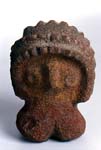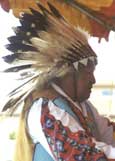 | Stone Head,
ca. pre-1800s |
Long before the coming of human peoples to these lands, the world was populated with powerful beings. Among them were Coyote, Salmon, Bear, Raccoon, and many other Animal People. These Animal People were powerful beings, with speech, thought, and human desires. But it was also a dangerous world, full of monsters, such as the “Swallower” who lived in the river’s deepest holes and would swallow up all those who came by. As Coyote and the others traveled up the rivers and over the lands, they confronted these monsters, and with their skill and cunning, outwitted and overcame these monsters. Two sisters prevented the salmon from going up river and it was Coyote who tricked them, releasing them so the human peoples would have food.
|
|
View some of the ancient rock art and She-Who-Watches, which can still be seen along the Columbia River. Learn from the Coyote story about the formation of this rock art. (From the video, Faith To Continuance, by David Schneiderman and Penny Phillips. © Mimbres Fever 2002. Used by permission.) |
In the collective actions of the Animal Peoples, the river gorges, plateaus and mountain ridges are formed, and the dead bodies of many of these monsters, now turned to stone, are continual reminders of the dangers. It was Coyote in particular who is our benefactor. While he can be mischievous, self-indulgent and very greedy, Coyote’s trickster character can also be self-effacing and noble. For it was Coyote and the others who thus helped prepare the world for the coming of the human peoples. The landscape was transformed and given its shape. Many of its monster and dangers were removed. And by their example, moral and practical teachings were embedded in their continuing stories.
The oral traditions that continue to be heard today include the handed-down accounts of Coyote, Raccoon and the other powerful beings. Conveyed within these stories is what is most cherished and true - the wisdom and teachings of survival, of heritage, of cultural identity for the families of the Warm Springs, Wasco and Paiute. There is humor and laughter. There is sorrow and grief. There are lessons of what is expected of a young woman or a young man. As Wilbur Johnson relates in his two stories shared here, there is the lesson about the importance of “patience” as taught by the Swallow, and the lesson about the importance of “assisting another” as taught by Deer. And there are many lessons of what is not expected, as in those examples of Coyote’s selfish misadventures. When he is self-serving, he typically fails in his schemes, but when he is self-effacing, thinking of goodwill to others, he likely succeeds in his endeavors. Indicated in many of the stories, as for example, in the story of “Seal Boy” (abbreviated below), the distinction between human and Animal peoples is very minimal. Such stories reiterate the kinship the Wasco, Warm Springs, and Paiute have with their natural world.
|
|
Suzie Slockish talks about the lessons that can be learned from the oral traditions, but also about how the legends are being lost. (Interviewed by Brigette Whipple, August 2003 |
Oral traditions are among our important educational textbooks. They tell of our origins and our destiny as Indian peoples. Who we are is what our ancestors have given us.
|
Seal Boy, a Wasco Story
One day, while the people were camped along the river, a father and his son were mending their canoe. After awhile, the boy disappeared. The people searched everywhere, without success. The boy was not found. A couple of years later some fishermen saw a great many seals and among them, a human boy. They reported this to the parents and they went to get their son back. They watched the seals and the boy, who swam and lived among them. When they went for him, he did not want to leave the seals and fought to stay with them. At first the boy would only eat raw salmon and fish and acted as a seal. After awhile, he finally became himself again. He told of many stories of how the seals had cared for him and that they were just like people. They moved about in the rivers just as the people did on land. But, whenever the camp was near the seals, the family covered the boy’s head, fearing he might return to them. One day, the boy threw the cover off and he swam out to the seals. He said, “I have a home down in the river and I will remain there from now on.”
|
To learn more about the role and importance of the oral traditions for Indain peoples, go to Oral Traditions in the Coeur d'Alene module.
© Confederated Tribes of Warm Springs 2003
< previous | next >
|




